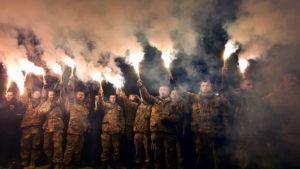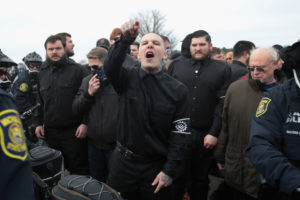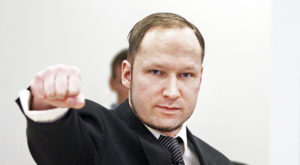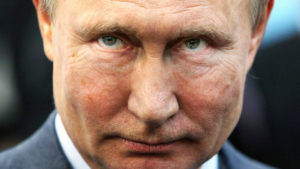Toby Cook was a 19-year-old with a history of mental health problems, a growing recreational drink and drug habit, and a mounting sheet of criminal charges when he decided to leave his native Australia and travel to Ukraine in 2018. He also happened to be a neo-Nazi.
The West was still panicking over Islamist extremism but far-Right violence was on the rise, and Ukraine’s Azov Battalion had become legendary in white supremacist circles. It had a reputation as the only well-armed and well-organised white nationalist group training foreign fighters as it battled Russian incursions into Ukraine. Toby was desperate to join them.
He had little interest, however, in the battle against Russian imperialism. And although he embodied the stereotypes of a far-Right thug, he had little interest in neo-Nazi ideology either. He slept under a swastika flag, wore T-shirts emblazoned with Nazi slogans, and would happily do Heil Hitler salutes for the camera while knocking back bottles of strong cider. But what mattered to him was having a cause, a purpose, and sense of meaning in his life — and that could have come from anywhere.
“If it had been radical Muslims who got to me before the far-Right, I probably would have joined ISIS,” he told me, after leaving the movement. “If it had have been radical leftists, I would have been a leftie.”
Throughout the 2010s, as many parts of the world experienced a surge in extremism, pre-conceptions flourished about what kind of person became what kind of extremist. Efforts to combat radicalisation, therefore, often focused on countering specific ideologies, rather than looking at the individual needs and broader social factors that drew people to fringe beliefs.
Measures to combat extremism in the UK and the US for a long time disproportionately targeted Muslim communities, for example. Meanwhile, public awareness campaigns supposedly tailored to people vulnerable to far-Right and conspiratorial disinformation ended up reinforcing narratives of a shady global cabal trying to brainwash people.
But in the years spent researching my book on extremism, for which I interviewed dozens of people who found themselves drawn to extreme beliefs, what was striking was how rarely people fit the narrow mould of who or what we might expect an extremist to be. A child of Muslim-American refugees who fled ethic nationalism in Bosnia is drawn to white supremacy. A Hindu nationalist becomes an Islamist extremist. A Norwegian aristocrat finds herself sucked into a Marxist cult. Toby has an Iranian grandfather, yet railed against non-white immigration.
Today, the Russian invasion of Ukraine is raising concerns about deeper radicalisation, in part because people like Toby are now being actively encouraged to head to the war zone. But the conflict has also exposed the shallowness and fluidity of extreme belief. If we examine activity in far-Right channels today, we see neo-Nazi, white supremacist, and conspiracy groups mobilising both for the Russian President and recruiting for Ukrainian militia.
This reveals the tangle of extremist contradictions that has been manipulated — and even manufactured — by the Kremlin over the past decade. As the EU bickered over the refugee crisis in 2015 and 2016, Putin saw his chance. Russia fuelled disinformation about migrants, including the infamous “Lisa case”, in which a German-Russian woman falsely accused a Muslim migrant of rape; the story was then amplified by Russian state media and the German far-Right. Many of Europe’s far-Right parties have received Russian funding, while the US intelligence community believes Russia provided indirect support to openly neo-Fascist groups too.
But now Putin justifies his brutal invasion of Ukraine by claiming to be countering extremism himself; he has promised the “de-Nazification” of Ukraine.
The far-Right’s response has not been coordinated. Some groups are spreading Russian disinformation; others are lionising Putin as a hero of the far-Right, with white nationalists fawning over his culturally conservative ideology. But other far-Right groups in Europe are encouraging their supporters to sign up to fight or fundraise for Ukrainian militia with white supremacist links, both because of ideological animosity towards Russia’s communist past and — more opportunistically — to gain direct military experience.
The far-Right ecosystem has never been a coherent space, encompassing everything from National Socialists to incels. But Tim Squirrell, who monitors far-Right activity for the Institute for Strategic Dialogue, believes the Ukraine War has the potential to split the far-Right more than any other issue. While he has observed many conspiratorial groups latching onto the false claims of US-funded bio-labs in Ukraine, there is still what he calls a “Balkanisation” of the space.
That fluidity does not necessarily harm the movement. QAnon showed that extreme beliefs do not have to be logical, and collective brainstorming is part of the draw for people seeking feelings of power and inclusion. “People can make all sorts of ludicrous, outlandish claims, and they won’t necessarily suffer for it, because the idea is that you are building a shared worldview,” Squirrell explains.
The far-Right’s contradictions over Ukraine demonstrate that extreme recruitment is not about ideology, but opportunism; it exploits individual human experience, rather than beliefs. While this shallowness may not undermine the movement, it can help us better understand why people are attracted by these groups, if it is not by the ideology itself.
“You need to understand what need a conspiracy, ideology, or a world view is filling for someone,” Squirrell says. “Once you identify that, then you can start to target it and try to understand what you might be able to do to get them out of it.”
It is more important than ever that we recognise this, given that the Covid-19 pandemic had already created the conditions for a surge in fringe beliefs. All the feelings that the pandemic sparked in the population — powerlessness, trauma, loneliness, alienation, fear, uncertainty, distrust — allow extremism to thrive. Indeed, Covid-19, like this war, upended some of our assumptions about who or what an extremist is, as we saw how people can cast around in a confused world and seek solace in conspiratorial narratives. The pandemic saw a convergence of the far-Right and far-Left around anti-vax and anti-lockdown movements, creating a confusion of paranoia and division.
Powerlessness is one of the strongest drivers of extremism — and powerless is how many now feel, watching the conflict between Ukraine and Russia from afar. The more uncertainty and fear there is in the world, the more we cling to those things that promise to bring meaning and control. Sanctions against Russia are also likely to lead to greater economic strain, and the political fringes are adept at exploiting financial hardship, as we saw during the eurozone crisis. And while most people volunteering to fight in Ukraine are not neo-Nazis, large numbers of people traveling to a foreign war zone carries inevitable radicalisation risks.
Toby never made it to Ukraine. Australian intelligence intercepted his communications, confiscated his passport, and enrolled him in a deradicalisation scheme. In the end, it wasn’t government intervention that drew him back from the brink, but encounters with ordinary people who simply engaged with him and showed him that he could live a fulfilling life outside of the far-Right. He has since left the neo-Nazi movement, and has spent the last few years reflecting on the underlying insecurities that drew him to the fringes of society.
Toby’s story illustrates the need for society to focus on the genuine drivers of extremism. The most successful counter-radicalisation programmes do not focus on changing people’s minds and refuting ideologies, but working on their underlying problems. After all, extremist recruiters know all too well the complex web of hopes, grievances, fears, insecurities and disappointments that can make people susceptible. Unless we recognise them too, the Ukraine War will be yet another global tragedy ripe for their exploitation.
Disclaimer
Some of the posts we share are controversial and we do not necessarily agree with them in the whole extend. Sometimes we agree with the content or part of it but we do not agree with the narration or language. Nevertheless we find them somehow interesting, valuable and/or informative or we share them, because we strongly believe in freedom of speech, free press and journalism. We strongly encourage you to have a critical approach to all the content, do your own research and analysis to build your own opinion.
We would be glad to have your feedback.
Source: UnHerd Read the original article here: https://unherd.com





